Six Color – Color Mixing Hot End for Reprap
This is my contribution to the RepRap project. See below for update.
I’ve been thinking about ways to make a color mixing hot end since I read Myles Corbett’s research.
This is a Bowden type extruder hot end that uses mechanical mixing, and has a water block or heatsinks for cooling.
It has a very short melt zone and uses stainless tubes to lower heat conductivity.
Materials:
- 3/4″ Copper rod for the hot end body (thermal conductivity: 204).
- 304 Stainless tube for the Bowden tube inserts, mixer tube (thermal conductivity 8.4 – 16).
- 304 Stainless rod for the mixer shaft.
- 1/2″ aluminum plate for the water block.
- Nichrome wire for heating element (and thermistor – not shown).
- Motor for rotating the mixer (stepper motor etc).
Here is the overall design (using a water block – see below for less complicated version):
The stainless tubes would be threaded into the hot end body.
Close up of Hot End:
A variation: use a mixer shaft that does not have a hex end, instead it would be full diameter so as to block all inlets – except for one vertical cut that would allow a single color to pass. The stepper motor would need an encoder to be able to determine it’s exact position. Then just rotate the shaft to the appropriate color for near instantaneous color change (if used that way then the mixing chamber would be shortened).
Update:
Thanks to feedback on the RepRap forum I have changed the design to be smaller, lighter, and easier to build.
I’ve removed the water block and replaced it with heatsinks which can be easily made (with a lathe) from 1″ aluminum round stock. They are just 0.6″ tall.
The filament tubes, mixer tube, and mixer shaft have been shortened.
A mounting plate can be screwed directly to the center heatsink, for mounting to the machine, and for mounting the mixer motor (DC or stepper). A baffle would need to be mounted between the heatsinks and the hotend body to keep air from blowing directly on it.
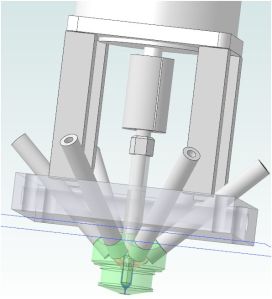
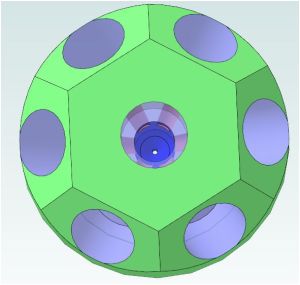
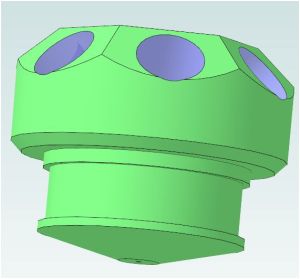
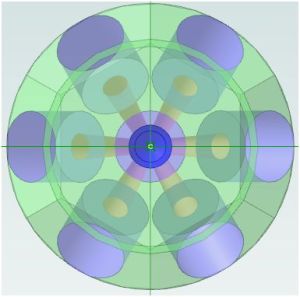
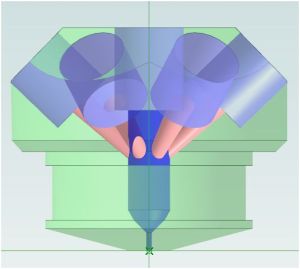
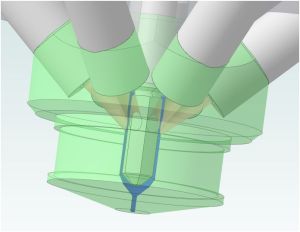
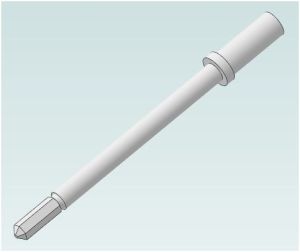
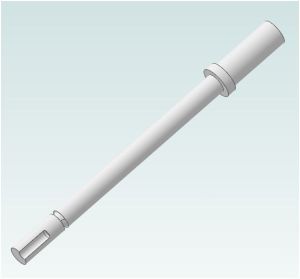
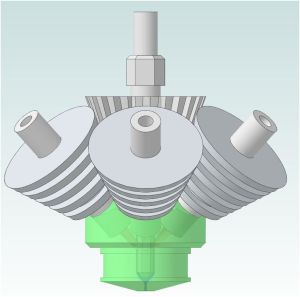
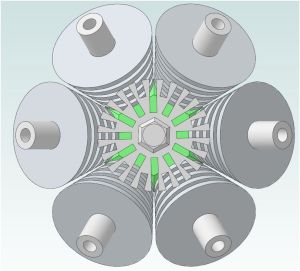
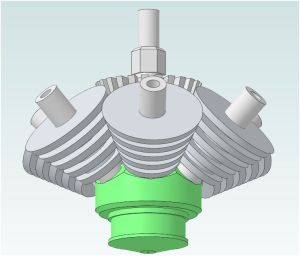

Hi
This is indeed interesting, did you pursue this further? any testing?
Thanks
06/04/2013 at 6:12 pm
Fadi,
Thanks for your interest.
I’ve published this to help others that are currently working on full color printing, and to publish the design as prior art so that it can remain open and free (see the developers forum at reprap.org).
I have a way to build the body mainly with just a drill press (using one wood fixture for accurate alignment), however the mixer shaft will require a metal lathe (which I do have access to). I will publish more about that when I have time there at Reprap.
The final design for the o-ring seal will take a bit of work, but this has been done already by Myles Corbett so it should be doable.
I also need to incorporate quick release connectors for the Bowden tubes.
I am currently busy working on hardware for a motion controller capable of handling all the extra steppers, using the new dual core Cortex M4/M0 chip by NXP running at 204 MHZ that has 1MB flash and 136K SRAM. This is the LPC4337JBD144E chip (in LQFP 144), Ive been waiting for this chip to come out for some time – and I finally have some on the way now. This should make it possible to have the motion planning performed by the M4 core (which has floating point), and have the M0 core dedicated to pulsing the steppers – I think it can do so without interrupts. This board is going to take some time to build, and the software as well.
06/05/2013 at 8:52 am
I am very interested in this design. Is there a link with the updated design and controller for the extra steppers?
04/13/2014 at 1:46 pm
I am very interested in this design and want to build it. Do you have the updated design with the o-ring and bowden quick release? Do you have a controller and software for the extra steppers? Do you have any measurements for the model, or a cad file? Have you done any more testing?
04/14/2014 at 5:33 pm
Karter,
Thanks for your interest.
I have been designing, and have now started building a new, large delta printer with over 14 inch diameter, 24 inch tall build area (enclosed). This uses magnetic ball joints, so I can swap out the effector/hotend assembly easily. Almost everything is custom: the all-metal hot-end (coaxially cooled), extruder, fan/heat-bed/light controllers, heat-bed power supply, heat-bed, bearing assemblies, a micro Hall-effect sensor for the auto-bed leveling, etc…
I finished ordering the last of the electronic parts, and I’m about a month away from completing this printer, which will start out single color, but is designed to accommodate the larger hot-end.
The 6-color hot end will need a few changes – the stainless tubes will have a slight bend so they point more vertically – for better clearance.
I will be looking at the software end after I dig into the Marlin firmware a bit. I know some on Reprap.org have done some work on this. I don’t think a regular Reprap (Atmel) style controllers will have enough processing power to do what I want to do. I have some plans in that regard (perhaps a color co-processor), but so many projects…
Check out developers forum on reprap.org
05/30/2014 at 8:06 pm
Thank you for replying to me. When you Finnish the Printer or continue work on the hot end please let me know.
Thanks,
Karter
06/05/2014 at 2:11 pm
Any progress on this design for the six color mixer? I am ready to build it and wondered if you have a cad file or 3d model for it that you could send me, or photos of each part with dimensions labeled.
I’m really interested in building this.
Thanks,
-Karter
09/17/2014 at 7:26 pm
So Very Very Awesome.
I haven’t built a reprap yet. But yours is the one I like best so far.
I think I want the largest build area I can manage. I had planned to do 4 colour but 6 has real possibilities. One for water soluble and one for 4 colour and white or an extra of a colour for faster build on the main colour?
I have just built my $35.00 Raspberry PI 2 (R-PI2) which is a B model with 4 processors!
I am using it for my desktop computer! I believe it should have the horsepower computationally to do pretty much as much as you want and have a core or two left over for the internet.
There are some kits for a little more that have a case and power supply and a
16 GB NOOBS class 4 SD card for a little more. (Don’t go over class 4 or it backward compatibles to class 1? I think??)
Anyway, I would love to be able to build a hot end with 5 or more colours.
I also saw someone with a fume hose and wonder if that would work better with a water cooled block?
I don’t know linux very well and maybe the arduino is still better!
All the software is written for the arduino. That is a big plus.
Also I really think a 3D printer even with 8 colours should not be too much for the arduino.
02/25/2015 at 1:36 am
Thanks Glenn,
I’m busy getting the last details of my printer done, just got the extruder working well, and found that using dampers on the Nema-23 steppers allows them to run over 3x as fast without stalling. I’ll be writing about that.
It will be a while before I can get back to the 6-color head, I want to make some changes and source some items before moving on it too.
As far as arduino or RPI, etc. I really think that Arduino is obsolete and shouldn’t be used for new repraps – too many compromises must be constantly made just to pump out the steps, it’s totally out of the question for a large delta. R-PI is being used for some Deltas now and that’s plenty fast, it’s really quite amazing.
I’m totally sold on the Smoothieboard tho, it’s worked perfectly… I so wish I had gotten it first instead of an arduino based board (Rumba). The Smoothie uses a 32-bit Cortex M3, and fully supports Repraps. Having extra cycles is going to be important with the extra extruders, and color mixing formulas.
02/25/2015 at 4:50 pm
Hello Paul,
I just got linked to your hotend work from the #reprap channel. Your open-source color-selecting bowden hotend shares some similarities with mine. I am new to the 3D printing world, and haven’t yet completed my first printer build, so I think I’m getting a little ahead of myself:P Awesome work though on the selecting hotend. Can’t wait to see it in action! Please email me so we can share ideas on the subject:)
08/26/2015 at 7:39 am
Jamie,
I have decided not to continue development on the hot end for now. I hope your development goes well.
Sorry for the delay in replying. I’m currently working on a gcode post processor for Slic3r to test several features I’d like to see in Slic3r, such as Pressure control, Coast While Retracting, and First Segment Acceleration. The combination of these three basic features will allow more precise printing at higher speeds.
While working on this project I came to realize that in order to calibrate these features it will require special test generators.
So I am also working on a full suite of test generators (over two dozen) that will be used to calibrate all printing parameters, by generating multiple instances of an object with a varying parameter, or creating test towers with sections of an incremented parameter. This will be called Guided Calibration.
So as you can see this is a quite a handful.
01/01/2016 at 8:55 pm